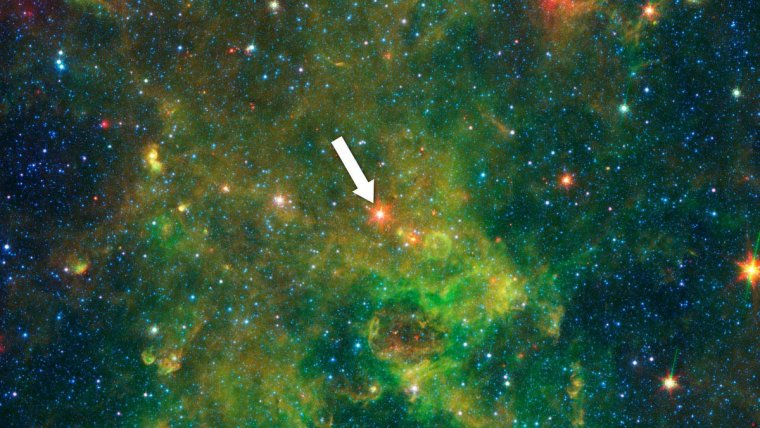| News / Space News |
NASA Team Probes Peculiar Age-Defying Star
NASA | SEPTEMBER 1, 2016
For years, astronomers have puzzled over a massive star lodged deep in the Milky Way that shows conflicting signs of being extremely old and extremely young.

An age-defying star called IRAS 19312+1950 exhibits features characteristic of a very young star and a very old star. It is the bright red star at the center of this image. ![]()
Researchers initially classified the star as elderly, perhaps a red supergiant. But a new study by a NASA-led team of researchers suggests that the object, labeled IRAS 19312+1950, might be something quite different -- a protostar, a star still in the making.
Located more than 12,000 light-years from Earth, the object first stood out as peculiar when it was observed at particular radio frequencies. Several teams of astronomers studied it using ground-based telescopes and concluded that it is an oxygen-rich star about 10 times as massive as the sun.
Some researchers favor the idea that the star is evolved -- past the peak of its life cycle and on the decline. For most of their lives, stars obtain their energy by fusing hydrogen in their cores, as the sun does now. But older stars have used up most of their hydrogen and must rely on heavier fuels that don't last as long, leading to rapid deterioration.
Two early clues -- intense radio sources called masers -- suggested the star was old. In astronomy, masers occur when the molecules in certain kinds of gases get revved up and emit a lot of radiation over a very limited range of frequencies. The result is a powerful radio beacon -- the microwave equivalent of a laser.
Scientists initially proposed that the object was an old star surrounded by a surprising cloud typical of the kind that usually accompanies young stars. Another idea was that the observations might somehow be capturing two objects: a very old star and an embryonic cloud of star-making material in the same field.
The researchers think the star is in a very early stage of formation. The object is much brighter than it first appeared, they say, emitting about 20,000 times the energy of our sun. The team found large quantities of ices made from water and carbon dioxide in the cloud around the object. These ices are located on dust grains relatively close to the star, and all this dust and ice blocks out starlight making the star seem dimmer than it really is.
In addition, the dense cloud around the object appears to be collapsing, which happens when a growing star pulls in material. In contrast, the material around an evolved star is expanding and is in the process of escaping to the interstellar medium. The entire envelope of material has an estimated mass of 500 to 700 suns, which is much more than could have been produced by an elderly or dying star.
YOU MAY ALSO LIKE

